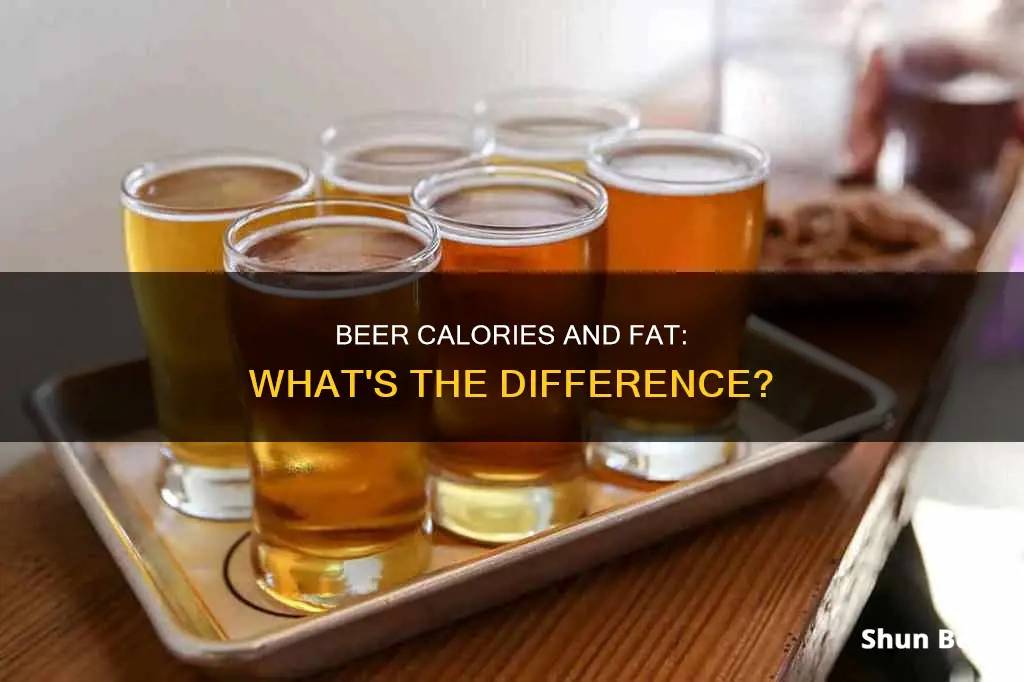
Beer is a popular alcoholic drink, but does it contain fat? Beer is made from fermented grains and contains calories from carbohydrates and alcohol. While beer does not contain fat, it can contribute to weight gain, including belly fat, if consumed in excess. The amount of calories in beer varies depending on the type and alcohol content, with darker beers generally having more calories. Excessive alcohol consumption can lead to health risks, and it's important to moderate intake and lead a healthy, active lifestyle.
| Characteristics | Values |
|---|---|
| Beer fat content | Beer has no fat. |
| Beer calories | Beer calories come from carbohydrates and alcohol. |
| Beer and weight gain | Drinking beer can cause weight gain, including belly fat. |
| Beer and health risks | Drinking more than 2 drinks per day for men and 1 drink per day for women increases health risks, including injuries and certain cancers. |
| Beer and appetite | Alcohol can increase your appetite. |
| Beer and fat burning | Drinking alcohol can prevent your body from burning fat. |
| Beer and phytoestrogens | Beer contains phytoestrogens, plant compounds that can mimic the action of the female sex hormone estrogen. |
What You'll Learn

Beer is high in carbs and alcohol but contains minimal protein
Beer is a popular alcoholic drink, but it is important to understand its nutritional composition, especially if you are watching your weight. Beer is made from grains and is a source of carbohydrates. It is typically high in carbs and alcohol but contains minimal protein.
The exact number of calories and carbohydrates in beer varies depending on the type of brew and the amount consumed. Dark beers, for example, tend to have more carbs than light beers due to the addition of malts during the brewing process. A 12-ounce can of ale, lager, porter, premium beer, or stout can contain more than 12 grams of carbohydrates, which is about four times the amount found in a light beer.
While beer supplies some protein, the amount is relatively small. A light beer may provide around 0.7 grams of protein, while a regular or dark beer may offer up to 1.6 grams. In comparison, other sources of protein provide significantly more.
The high carbohydrate and alcohol content in beer can have implications for weight management. Alcohol is particularly calorie-dense, with seven calories per gram. This is higher than the calorie content of carbohydrates and protein, which have four calories per gram. As a result, beers with higher alcohol content tend to be more calorific.
The calorie content of beer is primarily derived from carbohydrates and alcohol, with minimal contribution from protein. This composition can impact weight management, as excessive calorie intake can lead to weight gain. Therefore, it is important to consume beer in moderation and be mindful of its nutritional content, especially when trying to maintain or lose weight.
Additionally, beer is often associated with an increase in body fat, particularly around the belly, commonly known as a "beer belly." However, this is not solely due to the beer itself but rather the result of excessive calorie consumption, including calories from alcohol, sugary beverages, or high-calorie foods often consumed alongside beer.
Light Beer Calories: Modelo's Nutritional Breakdown
You may want to see also

Beer calories come from carbohydrates and alcohol
Beer is made from fermented grains such as barley, wheat, or rye. The calorie content of beer comes mainly from carbohydrates and alcohol. Brewers make beer by fermenting grains, which contain carbohydrates. Most beers also contain added sugars, which increase the carbohydrate level in the beverage. The number of grains and added sugars that remain in the beer varies according to the fermentation process.
Dark beers tend to have more carbs than light beers due to the way they are brewed with added malts. For example, a 12-oz can of ale, lager, porter, premium beer, or stout has more than 12 grams of carbohydrates. That's about four times more carbs than a light beer. Beer has no fat. Most of its calories come from carbohydrates.
Craft, seasonal beers, and beers with high alcohol content tend to have more calories than lighter beers. Beer is high in carbs and alcohol but low in almost all other nutrients. The calorie content of beer depends on its strength—the more alcohol it contains, the more calories it contains. Alcohol contains about seven calories per gram, which is higher than carbs and protein (four calories per gram) but lower than fat (nine calories per gram).
Beer is not a good source of nutrients like sodium, potassium, and magnesium, as you would need to drink massive amounts to satisfy your daily requirements. Beer also contains phytoestrogens from the flowers of the hop plant used to flavor it. Phytoestrogens are plant compounds that can mimic the action of the female sex hormone estrogen. It has been suggested that the phytoestrogens in beer might cause hormonal changes in men that increase the risk of storing belly fat.
Calorie Count in Molson Canadian Light Beer Revealed
You may want to see also

Beer has no fat content
The calorie content of beer depends on its strength, with a higher alcohol content resulting in more calories. Beer is high in carbohydrates and alcohol but low in other nutrients. A 12-ounce serving of regular beer with 4% alcohol content contains approximately 153 calories.
Beer may contribute to weight gain in several ways, including increasing calorie intake, preventing fat burning, and altering hormone levels. Studies have shown that drinking more than one beer per day or regularly binge drinking increases the risk of belly fat gain and other health problems.
While beer has no fat content, excessive consumption can lead to weight gain and other negative health consequences. It is important to consume beer in moderation and lead a healthy, active lifestyle to maintain a balanced diet and weight.
Calorie Counting: Asahi Beer's Nutritional Breakdown
You may want to see also

Beer contains phytoestrogens, which may increase the risk of storing belly fat
Beer is often associated with increased body fat, particularly around the belly, and is commonly referred to as a "beer belly". While beer does not contain fat, it does contain carbohydrates, proteins, and micronutrients such as sodium, potassium, and magnesium. However, the amount of these nutrients is very small and does not provide significant nutritional value. Beer is also high in calories, with a typical beer containing around 150 calories.
One of the reasons beer may contribute to belly fat is by increasing calorie intake. Beer contains a similar number of calories per gram as a soft drink, and alcohol can also increase appetite, leading to excess calorie consumption. Additionally, the body prioritizes the breakdown of alcohol over burning fat, which can prevent fat loss.
Another factor is the presence of phytoestrogens in beer. Phytoestrogens are plant compounds found in the flowers of the hop plant, which is used to flavour beer. These compounds can mimic the female sex hormone estrogen and may cause hormonal changes in men, potentially increasing the risk of storing belly fat. However, the exact impact of phytoestrogens on weight and belly fat is not yet known.
While moderate consumption of one beer per day or less is not linked to gaining a "beer belly", excessive drinking or regular binge drinking significantly increases the risk of belly fat and other health issues. Therefore, it is important to keep alcohol intake within recommended limits and maintain a healthy, active lifestyle to minimize the risk of weight gain.
Calories in Natty Daddy Beer: What's the Count?
You may want to see also

Beer has fewer calories than spirits and wine
Beer is often associated with weight gain, particularly around the belly, also known as a "beer belly". However, beer has fewer calories than spirits and wine. A standard 12-ounce (355-millilitre) serving of beer with 4% alcohol content contains approximately 153 calories. In comparison, a 1.5-ounce (45-millilitre) serving of spirits contains around 97 calories, and a 5-ounce (148-millilitre) serving of red wine contains about 125 calories.
The calorie content of beer depends on its strength; beers with higher alcohol content have more calories. Beer is typically made from grains and yeast, and the calorie content varies depending on the type of beer. Lighter-coloured beers tend to have fewer calories than darker beers due to their lower alcohol and ingredient density. For example, most light beers have between 60 and 120 calories, while dark beers have between 100 and 300 calories.
When comparing beer with spirits and wine, it's important to consider the serving sizes as well. A standard serving of spirits is typically smaller than a beer, and a standard serving of wine is usually smaller than both beer and spirits. Therefore, when comparing the number of calories in a serving, beer may still have fewer calories per serving than spirits and wine, even if the alcohol content is higher.
While beer has fewer calories than spirits and wine, it's important to note that excessive alcohol consumption of any kind can contribute to weight gain. Drinking more than one beer per day or regularly binge drinking increases the risk of belly fat gain and other health problems. Additionally, alcohol interferes with fat metabolism, as the body prioritises the breakdown of alcohol over other sources of fuel, including stored fat. Therefore, regular drinking, especially in larger quantities, can lead to an increase in body fat over time.
In conclusion, while beer has fewer calories per serving than spirits and wine, moderate consumption is key to maintaining a healthy weight. Excessive alcohol intake, regardless of the type of beverage, can lead to weight gain and negatively impact overall health.
The Calorie Count of Hamm's Beer Explained
You may want to see also
Frequently asked questions
Beer is high in calories and carbohydrates, which can lead to weight gain if consumed in excess. Beer also contains alcohol, which can prevent your body from burning fat. Therefore, drinking beer regularly and in large quantities can contribute to an increase in body fat, including belly fat.
The calorie content of beer depends on its strength or alcohol content. Beers with higher alcohol content tend to have more calories. The type of beer also matters, with craft, seasonal, and dark beers generally having more calories than lighter beers.
Beer tends to contain more calories than wine or spirits like whiskey. For example, a standard serving of beer (12 oz or 355 ml) typically has around 153 calories, while a 5-oz serving of red wine contains 125 calories, and 1.5 oz of spirits has about 97 calories.
Yes, if you're concerned about calorie intake, you can opt for alcohol-free or light beers, which usually have fewer calories. Some specific examples include Bud Select (55 calories), Michelob Ultra (95 calories), and Miller Light (96 calories).
To avoid weight gain, it's important to consume beer in moderation and maintain a healthy, active lifestyle. Stick to the recommended limits of no more than two drinks per day for men and no more than one drink per day for women. You can also try strategies like drinking water between alcoholic beverages or adding fruit to your beer for a nutritional boost.







